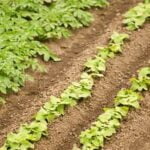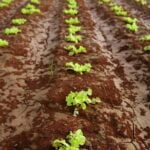Are you ready to take your gardening skills to the next level and conquer the unique challenges of Zone 5 vegetable gardening? In this comprehensive guide, we will explore the ins and outs of successful vegetable gardening in Zone 5, including essential tips and techniques for a thriving garden. Whether you are a seasoned gardener or just starting out, these zone 5 vegetable gardening tips will help you make the most of your growing season and produce a bountiful harvest.
Zone 5 encompasses a wide range of climates and weather patterns, presenting both opportunities and challenges for vegetable gardeners. From short growing seasons to harsh winters, the climate in Zone 5 can significantly impact the success of your vegetable garden. Understanding these factors is key to creating a resilient and productive garden that can withstand the local conditions.
In this article, we will delve into the best vegetables to grow in Zone 5, as well as how to choose the right soil and fertilizers for optimal growth. Additionally, we’ll discuss essential techniques such as starting seeds and transplanting in Zone 5, managing pests and diseases, watering and irrigation strategies, harvesting, maintaining your garden, and more.
By the end of this guide, you’ll have all the knowledge you need to cultivate a thriving vegetable garden in Zone 5.
Understanding the Zone 5 Climate and Its Impact on Vegetable Gardening
Zone 5 climate can be challenging for vegetable gardening, but with the right knowledge and techniques, it is possible to have a successful and productive garden. Understanding the specific climate of Zone 5 is crucial for knowing what vegetables will thrive, how to care for them, and how to protect them from the elements.
In Zone 5, the weather can be quite unpredictable, with cold winters and warm summers. This means that vegetable gardeners need to plan accordingly and choose vegetables that can withstand these temperature extremes. Some popular vegetables that do well in Zone 5 include carrots, radishes, lettuce, peas, and onions. It’s important to consider the average last frost date in the spring and first frost date in the fall when planning out your planting schedule.
When it comes to soil type, Zone 5 vegetable gardening benefits from well-draining soil with plenty of organic matter. Adding compost or aged manure can improve soil structure and fertility. As for fertilizers, choosing a balanced fertilizer with equal parts nitrogen, phosphorus, and potassium can help provide essential nutrients for vegetable growth. It’s also important to test the soil pH and make adjustments as needed to ensure optimal growing conditions for your vegetables.
Some helpful tips for successful Zone 5 vegetable gardening include:
- Start seeds indoors early to give your plants a head start before transplanting them outdoors.
- Cover plants during unexpected late frosts in the spring or early frosts in the fall using row covers or cloches.
- Mulch around your vegetable plants to help retain moisture in the soil and regulate soil temperature.
By understanding the unique climate of Zone 5 and implementing these tips for soil preparation, fertilization, seed starting, transplanting, pest management, watering techniques, and harvesting practices, you can create a thriving vegetable garden despite the challenges of this climate zone.
Best Vegetables to Grow in Zone 5
When it comes to zone 5 vegetable gardening, it is important to choose the right vegetables that can thrive in this specific climate. The short growing season and fluctuating temperatures in zone 5 can make it challenging to grow certain vegetables, but with the right selection, a successful harvest is still very achievable.
Some of the best vegetables to grow in zone 5 include cold-hardy options such as carrots, beets, radishes, and lettuce. These vegetables are able to withstand the cooler temperatures and even some light frosts, making them perfect for early spring or late fall planting. Other popular choices for zone 5 vegetable gardening include tomatoes, peppers, and cucumbers, which can be grown successfully with a little extra care and attention.
Leafy greens like spinach, kale, and Swiss chard also do well in zone 5, thriving in cooler temperatures and adding nutritional value to your garden. Root vegetables such as potatoes and onions are also viable options for zone 5 vegetable gardening due to their ability to withstand colder conditions and store well for later use.
Additionally, it is important to consider companion planting when selecting vegetables for your zone 5 garden. Certain plants can benefit from being grown together while others may inhibit each other’s growth. By choosing the best vegetables for your zone 5 garden and considering their compatibility with one another, you can set yourself up for a successful harvest.
Choosing the Right Soil and Fertilizers for Zone 5 Vegetable Gardening
When it comes to zone 5 vegetable gardening, one of the most important factors for success is choosing the right soil and fertilizers. The soil in this climate can vary widely, from heavy clay to sandy loam, so it’s crucial to understand your specific soil type and make necessary amendments. Conducting a soil test can provide valuable information on pH levels, nutrient content, and organic matter, which will guide you in selecting the right fertilizers and soil amendments.
In general, vegetables thrive in well-draining soil with a pH level between 6.0 and 7.0. Adding organic matter such as compost or aged manure can improve soil structure, fertility, and moisture retention. For acidic soils, adding lime can help raise the pH level. Additionally, nitrogen-rich fertilizers are essential for promoting healthy foliage growth, while phosphorus and potassium are important for root development and overall plant health.
It’s important to note that some vegetables have specific soil requirements. For example, carrots and other root crops prefer loose, rocky-free soil to prevent forking or stunted growth. On the other hand, brassicas like cabbage and broccoli benefit from a steady supply of nitrogen-rich fertilizers to support their rapid growth. Understanding the unique needs of each vegetable will allow you to tailor your soil amendments and fertilization practices accordingly.
| Soil Test Components | Ideal Levels |
|---|---|
| pH Level | Between 6.0 to 7.0 |
| Nutrient Content | Depends on specific vegetable needs |
| Organic Matter | Aim for at least 5% organic matter |
Tips for Starting Seeds and Transplanting in Zone 5
When it comes to starting seeds and transplanting in Zone 5, timing is crucial. The last average frost date in Zone 5 typically falls between late April and mid-May, which means that starting seeds indoors a few weeks before this date can give your plants a head start.
Some vegetables that thrive in Zone 5, such as tomatoes and peppers, require a longer growing season than the climate allows. Starting these seeds indoors is essential to ensure a successful harvest.
Transplanting seedlings into your garden requires careful planning as well. Harden off your seedlings by gradually exposing them to outdoor conditions for a few hours a day over the course of a week before transplanting them. This will help them acclimate to the outdoor environment and reduce the risk of transplant shock. When transplanting, be mindful of the spacing requirements for each vegetable and provide adequate support for vining plants like cucumbers or pole beans.
In addition to proper timing and transplantation techniques, it’s important to consider soil temperature when starting seeds outdoors in Zone 5. Some vegetables, such as carrots and lettuce, can be directly sown into the ground as soon as it’s workable, usually around mid-April. Keeping track of soil temperature with a soil thermometer can help you determine the best time for planting various vegetable seeds directly in your garden.
| Vegetable | Recommended Method |
|---|---|
| Tomatoes | Start seeds indoors 6-8 weeks before last frost date |
| Cucumbers | Directly sow seeds after last frost date; provide trellis for support |
| Lettuce | Directly sow seeds as soon as soil is workable; prefers cooler temperatures |
Managing Pests and Diseases in Zone 5 Vegetable Garden
Pests and diseases can pose a significant challenge to vegetable gardening in Zone 5. However, with the right knowledge and proactive measures, it is possible to effectively manage these issues and protect your plants. Here are some tips for managing pests and diseases in your Zone 5 vegetable garden:
1. Identify common pests and diseases: It’s essential to familiarize yourself with the various pests and diseases that are prevalent in Zone 5. Some common pests include aphids, caterpillars, and beetles, while diseases such as powdery mildew and blight can affect vegetable plants. By knowing what to look out for, you can take early action to prevent infestations and infections.
2. Implement companion planting: Companion planting involves growing certain plants together to naturally repel pests or attract beneficial insects. For example, planting marigolds alongside your vegetables can help deter nematodes, while luring ladybugs that feed on aphids. Consider incorporating companion plants into your garden layout to create a more balanced ecosystem.
3. Use organic pest control methods: Instead of resorting to chemical pesticides, opt for organic pest control methods such as neem oil spray, insecticidal soap, or diatomaceous earth. These natural options can effectively target pests while minimizing harm to beneficial insects and the environment.
4. Practice good garden hygiene: Regularly inspect your plants for signs of pest infestations or disease symptoms, such as wilting leaves or discoloration. Remove any affected plant parts promptly and dispose of them away from the garden area to prevent the spread of pests and pathogens.
By incorporating these strategies into your Zone 5 vegetable gardening routine, you can minimize the impact of pests and diseases on your crops while promoting a healthy and thriving garden ecosystem.
Watering and Irrigation Techniques for Zone 5 Vegetable Gardening
Understanding Watering Needs in Zone 5
In Zone 5, where the climate can be unpredictable and prone to temperature fluctuations, it’s important to understand the watering needs of your vegetable garden. The summer months can bring hot and dry weather, while spring and fall may see more rainfall. It’s crucial to monitor the moisture levels in the soil and adjust your watering schedule accordingly.
Choosing the Right Irrigation Method
There are several irrigation methods that can be effective for zone 5 vegetable gardening. Drip irrigation systems are a great option as they deliver water directly to the base of plants, reducing water waste. Soaker hoses and soaker tapes are also beneficial as they ensure deep root penetration without wetting the foliage. Overhead sprinklers should be used sparingly, if at all, as they can promote disease by wetting the leaves.
Conserving Water in Zone 5 Vegetable Gardening
Given that zone 5 may experience periods of drought, it’s important to conserve water in your vegetable garden. One way to do this is by adding a layer of mulch around your plants to retain soil moisture. Additionally, consider collecting rainwater in barrels during the wetter months to use during drier periods. By being mindful of water usage and implementing conservation techniques, you can ensure a successful vegetable garden in Zone 5.
Harvesting and Maintaining the Vegetable Garden in Zone 5
Once you have successfully grown your vegetables in Zone 5, it’s time to harvest and maintain your vegetable garden. Harvesting at the right time is crucial to ensure that you get the best flavor and quality from your produce. Be sure to regularly check for ripe fruits or vegetables and harvest them promptly. Leaving them on the plant for too long can result in a decline in flavor and texture.
In Zone 5, maintaining the vegetable garden also entails taking care of the plants even after the harvesting period. After harvesting, clear out any remaining plant debris to prevent pests and diseases from spreading. Additionally, consider planting cover crops during fall to help protect and enrich your soil during winter. This will help prepare your garden for the next growing season.
It’s also important to continue watering and fertilizing your vegetable garden as needed even after harvesting is done. Proper maintenance will not only improve the health of your soil but also ensure that it is ready for next year’s planting season. Keep an eye on weed growth as well, as they can compete with your vegetables for water and nutrients. Regular weeding is essential for maintaining a healthy vegetable garden in Zone 5.
Conclusion and Final Tips for Successful Zone 5 Vegetable Gardening
Protecting Your Garden From Frost
In Zone 5, frost can be a significant concern for vegetable gardeners. It’s important to take measures to protect your plants from late spring and early fall frosts. Using row covers or cloches can help to shield delicate plants from colder temperatures. Additionally, planting cold-hardy vegetables and using mulch can provide some insulation and protection from frost.
Extend Your Growing Season
To make the most of your Zone 5 vegetable garden, consider ways to extend your growing season. Utilizing hoop houses or cold frames can help to keep plants warm as temperatures begin to drop. Additionally, choosing quick-maturing varieties and succession planting can ensure a continuous harvest throughout the growing season.
Utilize Companion Planting
Companion planting is a beneficial technique for Zone 5 vegetable gardening. By interplanting compatible crops, you can naturally deter pests, improve soil health, and enhance overall plant growth. For example, planting aromatic herbs like basil or dill alongside your vegetables can help repel unwanted insects.
By taking these final tips into consideration, you can set yourself up for success in your Zone 5 vegetable garden. With careful planning and attention to the unique climate and conditions of Zone 5, you can enjoy a bountiful harvest of fresh, homegrown produce throughout the growing season.
Resources and Further Reading for Zone 5 Vegetable Gardening Tips
In conclusion, zone 5 vegetable gardening can be a rewarding and fruitful endeavor with the right knowledge and preparation. Understanding the unique climate of zone 5, including its frost dates and temperature fluctuations, is essential for successful vegetable gardening. By selecting the best vegetables for this climate, such as cold-hardy varieties like kale, carrots, and broccoli, gardeners can ensure a bountiful harvest.
Choosing the right soil and fertilizers tailored to the needs of zone 5 vegetables is crucial for optimal plant growth and development. Starting seeds indoors and transplanting them at the appropriate time will give plants a head start and increase their chances of thriving in the garden. Additionally, implementing effective pest and disease management strategies, along with proper watering techniques and irrigation methods, are key factors in maintaining a healthy vegetable garden in zone 5.
As gardeners continue to care for their zone 5 vegetable garden throughout the growing season, it is important to monitor the progress of the plants and harvest vegetables at their peak ripeness. By following these tips and guidelines for zone 5 vegetable gardening, individuals can enjoy a successful harvest while nurturing their passion for gardening in this unique climate.
For those interested in delving deeper into zone 5 vegetable gardening tips, there are numerous resources available that provide additional information on specific vegetables to grow, soil maintenance techniques, pest control methods, and more. Whether through books, online articles, or local gardening communities, enthusiasts can continue to expand their knowledge and enhance their skills in zone 5 vegetable gardening.
Frequently Asked Questions
What Veggies Grow Best in Zone 5?
Vegetables that grow best in Zone 5 include carrots, beets, lettuce, spinach, peas, radishes, and kale. These cool-season crops thrive in the shorter growing season and cooler temperatures of Zone 5.
Is It Too Late to Plant Vegetables in Zone 5?
It may not be too late to plant vegetables in Zone 5, depending on the specific vegetable and the first frost date for your area. Quick-maturing crops like lettuce, radishes, and spinach can still be planted in late summer for a fall harvest.
When Should Zone 5 Be Planted?
In Zone 5, vegetables should generally be planted after the last frost date in spring, which typically ranges from mid-April to late May. It’s important to consult local gardening resources or extension offices for specific planting dates based on your location within Zone 5.

If you’re looking to get into vegetable gardening, or are just looking for some tips on how to make your current garden better, then you’ve come to the right place! My name is Ethel and I have been gardening for years. In this blog, I’m going to share with you some of my best tips on how to create a successful vegetable garden.





